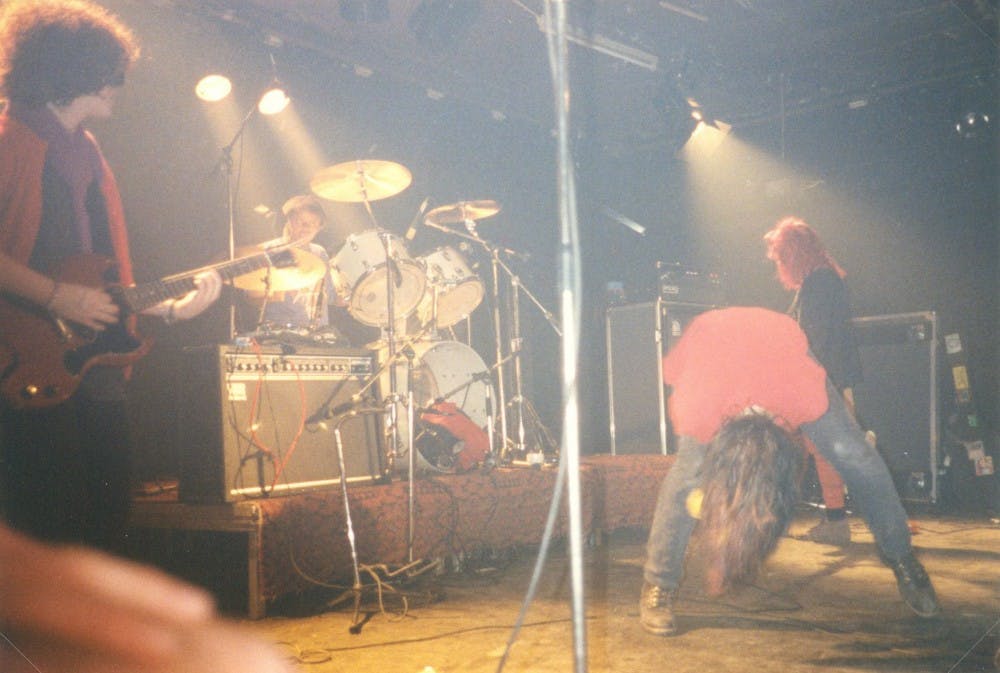The District goes by many aliases, The Hollywood for Ugly People, American Rome and Chocolate City. But "hardcore” is rarely used to describe the Capital. For the few visitors of the District who venture up north past the government buildings and Smithsonian museums, the term hardcore starts to become more recognizable. In Adams Morgan and the U Street corridor, remnants of D.C.’s past hardcore punk scene can be seen from the street artwork all the way to the businesses that continues to celebrate the city’s rebellious past.
Set on the Adams Morgan strip, the punk rock vinyl store Smash Records still holds onto the 1980’s D.C. hardcore scene, and sells everything from vinyl to black leather jackets and patches. Co-owner Matt Moffatt reopened the shop at Adams Morgan back in 2007 after its first location closed in Georgetown. Smash Records is located at 2314 18th St. NW, just a few blocks from one of the birthplaces of D.C. punk, Madam’s Organ.
Unlike the bar that also sits on 18th Street, the venue of Madam’s Organ does not exist anymore. The venue was a place where prominent hardcore punk pioneers such as Bad Brains and Minor Threat first got their starts. According to Moffatt, the closed venue, which was a “Yippie” commune, is not the only place where the D.C. punk scene can trace its roots back to.
“You can still find many connections in different ways,” Moffatt said. “They have small shows at the church at Mount Pleasant Street, and you can trace way back to a girl who was in Fire Party, another 80’s D.C. punk band. Your lineage can be traced back to that, and, I think, unlike maybe other bigger cities, [D.C. is] small enough where it can be a little bit more community based.”
Just down 18th Street south of Smash Records lies another vinyl store that has been in existence for the past 13 years, Crooked Beat Records. Unlike Moffatt’s store, Crooked Beat Records only sells vinyl, and attracts an older age group, including singer of Minor Threat, Ian Mackaye, and Black Flag vocalist Henry Rollins.
The owner of the store is a 52-year-old Silver Spring native, Bill Daily, who experienced a lot of the D.C. hardcore scene back in its heyday. Similar to Moffatt, Daily said the D.C. music scene was small but not just about the music.
“Back then, D.C. was kind of a smaller place, in a lot of ways,” Daily said. “There were a lot of people that didn’t know about Minor Threat and the Bad Brains back then. It was more of an underground support group.”
While the city’s hardcore scene may have been full of supportive individuals, it was not kind to all who wanted to be a part of it. For Montana native Mark Anderson, who moved to D.C. in between Adams Morgan and Dupont Circle in 1984, the scene was not at all what he expected, as he casually saw Nazi punk graffiti around the streets of his neighborhood.
“I knew there was a thriving scene here, which was kind of unusual for Washington, D.C.,” Anderson said. “D.C. is not a rock and roll city historically. So, I came here and what I saw in the D.C. scene was by in large very disturbing initially. There was a skinhead gang that was kind of terrorizing the scene.”
According to Anderson, most of the skinheads were anti-racist, but they leaned to the extremes of right wing politics, such as Nazi imagery and anti-gay beliefs.
Interacting with other angry punks in the D.C. scene prompted Anderson to do something productive using the energy of outrage. In June 1985, Anderson cofounded the activist organization Positive Force. The activist organization continues to hold benefit concerts for charities, organize protests and conduct service opportunities in the D.C. area today.
“The question is, what do you do with [outrage],” Anderson said. “ Are you just going to get cynical and make fun of everything? That’s one option. I think a real punk does something about it. … So basically this rhetoric of criticism against the world is also a challenge for us to become activists, to do something about it. So that’s really my impetus for helping to start positive force.”
When it comes to the actual music scene, Anderson claimed that D.C. was the “single most influential cutting edge punk scene ever.” However, Anderson also believes the punk scene has now evolved into the cultural image of the city.
According to Anderson, the D.C. scene has become larger and diffuse. He says venues like the 9:30 Club and and the Black Cat specifically came out of the District’s punk scene.
“The punk scene has become the Rock and Roll establishment of D.C,” Anderson said.
The scene was an especially rigorous place for the women who were trying to break into the boy’s club mentality.
AU alumna Natalie Avery was part of one of the first punk bands in D.C. to feature all female members. Avery played lead guitar and also sang for her band, Fire Party. She graduated from AU in 1991 as a literature major, and then came back to achieve her masters in the School of International Service in 1998. The 49-year-old now is a mom and works in consulting.
Growing up in Friendship Heights, Avery chose American University because of its location within D.C. Avery found herself entrenched in the music scene, working at a record shop prior to her going to school. AU was an entirely different school back when she first attended it in 1986, according to Avery.
She started her band beforeprior to coming to college in response to a heavily male oriented scene.
“It was kind of the way things were. The guys were usually the center of attention, the center of that scene,” Avery said. “So, when Fire Party started, it was not so much ‘let's start a band and tour the world and put out a record,’ it was like, ‘lets just drive to the beach together, just us.’ … Having a space where we were our own center of attention.”
While many in the scene were supportive of Fire Party, Avery said it was hard to escape the spectacle some had of an all-girl band. Avery’s band toured Holland with another D.C. band, Scream, whose members included the Foo Fighter’s David Grohl just a few years before he played drums for Nirvana. While touring, a local zine attempted to review Avery’s band.
“Most girl bands either rely on their looks, or they suck, and then [the article] said Fire Party are neither of these, because they definitely can't rely on their looks and they don’t suck. In fact they are really good,” Avery said.
As much as Avery and her band members tried to diffuse the label of being a part of an all- girl band, critics continued to stereotype the group.
“We got a lot of questions like ‘what is it like to be in a girl band?’ and we were really like, ‘well it’s just the same as being in any other band,’” Avery said. “We just wanted to be accepted for being in a band. And every time you try to put us in this category of a girl band, or say things like how do you compare to the Bangles or the Go-Go’s, as though you are sort of a category of music.”
Although Fire Party broke up in 1990, Avery still considers herself a punk. Married to her husband Eddie Janney, who was also a part of another D.C. band called Rites of Spring, the couple have two kids and continue to live in the city.
“I hope punk is not dead,” Avery said. “Punk was about liberation from all of those structures that come from a society where corporations and money capital have so much power in terms of shaping your identity, and how you relate to people, and how you live, and what you buy and what you listen to. I feel so lucky to have been a part of this movement.”





